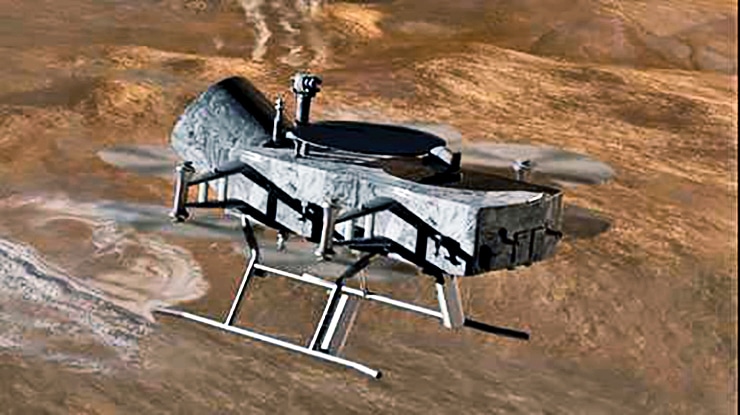Scientists want to send an insect-like dual-quadcopter to Saturn’s moon, Titan, then fly it from place to place to explore the possibility that life could develop there.
“We could take a lander, put it on Titan … at one place and significantly increase our understanding of Titan and similar moons,” says Peter Bedini, Dragonfly project manager at the Applied Physics Laboratory at Johns Hopkins University.

“However,” he says, “we can multiply the value of the mission if we add aerial mobility, which would enable us to access a variety of geologic settings, maximizing the science return and lowering mission risk by going over or around obstacles.”
APL is pitching Dragonfly to NASA as a New Frontiers-class mission concept. If it’s eventually selected for flight, it would ferry science instruments to various landing zones on Titan—the solar system’s second-largest moon, larger than Mercury.
Dragonfly, designed with four pairs of spinning rotors on two levels, resembles and is named for Earth’s double-wing-set-equipped insect, which also hops from place to place.
Although the idea of exploring Titan by rotorcraft is not new, technological developments in the past two decades—sometimes referred to as the “drone revolution”—have made such a mission more feasible.
“This is the kind of experiment we can’t do in the laboratory…”
Titan is one of a number of “ocean worlds” in our solar system that hold the ingredients for potential life. Its surface is dominated by water ice and it has an interior ocean. It’s known to be covered with rich organic material undergoing chemical processes that might be similar to those that occurred on early Earth, before life developed.
“This is the kind of experiment we can’t do in the laboratory because of the time scales involved,” says APL’s Elizabeth Turtle, principal investigator for the proposed Dragonfly mission.
Titan’s tiny waves could make for a smooth landing
“Mixing of rich, organic molecules and liquid water on the surface of Titan could have persisted over very long timescales. Dragonfly is designed to study the results of Titan’s experiments in prebiotic chemistry,” she explains.
With Titan’s dense atmosphere and low gravity, flight is substantially easier there than on Earth, so Dragonfly would make numerous flights, moving from one geologic setting to another. At each, it would sample the surface and atmosphere, characterizing the habitability of Titan’s environment, investigating how far prebiotic chemistry has progressed, and searching for chemical signatures indicative of water- and/or hydrocarbon-based life.
The instrument-laden craft would make four types of observations. Mass spectrometry would reveal the composition of the surface and the atmosphere. Gamma-ray spectrometry would measure the composition of the shallow sub-surface. Meteorology and geophysics sensors would measure atmospheric conditions such as wind, pressure, temperature, and other factors, as well as seismic activity. Cameras would characterize the geologic and physical nature of the moon’s surface, and help find subsequent landing sites.
Later this fall, NASA is expected to select a few New Frontiers mission proposals for further study. Eventually, only one will be chosen for flight, becoming the fourth mission in the planetary exploration program. Final mission selection is expected in mid-2019.
Grains on Titan would cling to a spacecraft ‘like packing peanuts’
The APL-led New Horizons mission to Pluto and the Kuiper Belt was the first New Frontiers mission ever selected. Find out more about the Dragonfly mission here.
Source: Johns Hopkins University



